Pizza is ubiquitous in America today and is served for many a meal. You find it sold almost everywhere, in airports and food courts, at sporting events and kid- and family-focused events, as well as at the obvious places: pizzerias, moderately priced Italian restaurants, and many American and family-style restaurants.
Believe it or not, according to the Dietary Guidelines for Americans 2010 report, pizza was the fifth leading source of calories for Americans! That’s not because it’s so high in calories, but because we eat it so often!
Pizza ranks number one among the foods delivered most frequently to homes, offices, and more. In other words, Americans have grown a bit dependent on pizza. Pizza is Italian in origin, but because it’s now such a central food item in American cuisine, it gets its own chapter in this book. For information on other Italian fare, see Chapter 19.
Many national chains are dedicated to serving pizza both in their sit-down restaurant and as carryout orders, so you can whisk the pizza home (or elsewhere) and enjoy it at your dining room table. Among the big pizza chains of this type are Pizza Hut, Godfather’s Pizza, Cici’s Pizza, Uno Pizzeria & Grill, and Round Table Pizza. Some of the largest pizza chains, like Domino’s, Papa John’s Pizza, Little Caesars, and Papa Murphy’s Take ‘N’ Bake offer pizza for takeout or delivery only. Sbarro’s specialty is lining food courts or airport terminals, and Chuck E. Cheese’s caters to the younger crowd by integrating food and free-for-all playtime into one kid-friendly experience. Then there are the more upscale, sit-down pizza establishments, which boast pizza made in wood-fired or brick ovens and sport a wide array of less-common toppings, such as goat cheese, spinach, pesto, and roasted red peppers. Bertucci’s and California Pizza Kitchen are two national sit-down restaurant chains in this category. A plethora of independent pizzerias line America’s highways, byways, and city streets as well.
![]() On the Menu
On the Menu
Pizza is a favorite with every age group. Eat it hot or cold. You can have it for lunch, dinner, a late-night snack, or even eat a leftover slice for breakfast.
Pizza can be healthy—in fact, it can be healthier than many a burger-and-fries meal—if you put The 10 Skills and Strategies for Healthier Restaurant Eating (Chapter 4) into action. One of the best things about pizza is it’s most often made to order, making it easy to customize your pizza and make it as healthy as you can.
But you’ve got decisions to make along the way if you’re going to enjoy a healthy piece or two of pizza. You’ll need to choose the thickness of the crust, the amount of cheese you want, the toppings, and most importantly, how many pieces you’re going to eat. Not overeating is the biggest challenge with pizza. One or two slices seem to always be left on the tray, begging you to chow them down.
Put these portion-control strategies to work when ordering pizza: Practice portion control from the start by ordering fewer slices or a smaller-size pie and stop eating when you’re full. Then pack up the extra pieces to go.
Thin, thick, stuffed crust, deep dish—yes, the thickness of the crust is the next decision to tackle. Most pizza restaurants offer a variety from thin to thick. If calories and your carbohydrate count are your biggest concern, then thin crust is the way to go. Generally, the thicker the crust, the higher the calorie and carbohydrate counts. If you enjoy a thicker crust and you’ve got the calories and carbohydrate grams to spare, then order a thicker-crust pizza but eat only a few slices.
Another bit of advice: enjoy a salad alongside your pizza. Not only will a salad allow you to check off one or two more vegetable servings that day, but it will also fill you up and won’t leave as much room for that extra piece of pizza that you shouldn’t really have. Most restaurants that serve pizza sit-down style also offer salads. Even most corner pizza parlors offer a garden or Greek salad. Don’t forget the salad mantras: watch higher-fat add-ons and order dressing on the side. Munch on the salad first, prior to eating the pizza. Chapter 15 provides all the information you need to keep your salads healthy and dress them for success.
![]() The Menu Profile
The Menu Profile
Pizza Types
Styles of pizza have been influenced by regions around the country and globe. You may even have a unique style in your own hometown. Some pizzerias offer several types of pizza, while others serve just one type. While any type of pizza can be made more or less healthy depending on which topping you order, some pizza styles are inherently lower in calories, thanks largely to their thin crust. Thinner crusts generally have fewer calories than thicker crusts, plus they physically can’t hold the weight of lots of cheese and other high-fat toppings. This helps them win a few extra points toward healthfulness.
Here’s a brief overview of a few of the pizza styles served across the United States.
• Chicago-Style Deep Dish Pizza: This is a knife-and-fork pizza that is almost akin to a casserole, since it’s baked in a deep pan. It has a buttery crust and is layered from the bottom up with sliced (yes, sliced) mozzarella, meats, and veggies, then topped with sauce and more cheese (this time grated). An “individual size” deep dish pizza topped with cheese and tomato at Uno Pizzeria & Grill weighs in at 1750 calories, more than half of which come from fat! If the occasion calls for deep dish, limit yourself to just one piece and opt for low-calorie vegetables as your toppings.
• Gourmet Pizza: Pizzas are considered “gourmet” when high-quality and/or unique toppings are emphasized. You may find gourmet pizzas at upscale Italian restaurants, at the new crop of “bake at home” pizzerias, or at California Pizza Kitchen, the restaurant chain that originally made gourmet pizzas with inventive toppings go mainstream. Peanut sauce and Thai veggies on your pizza? When it comes to gourmet pizzas, take advantage of the wide array of vegetables available, the whole-grain crust options, and the leaner protein topping choices such as grilled chicken, turkey sausage, or shrimp.
• Neapolitan Pizza: These thin-crust pizzas are usually about 10 inches in diameter and are made in a traditional wood-burning oven. The crust is moist and chewy toward the center of the pizza and slightly puffy and charred toward the crust. Perhaps the most popular Neapolitan pizza is the Margherita, which is topped with fresh tomato sauce, fresh buffalo mozzarella, and basil (the colors of the Italian flag). As far as pizzas go, Neapolitan pizzas are generally lower in calories and fat than other versions, thanks to the thinner crust and lighter hand used when sprinkling on the cheese. However, most restaurants that serve Neapolitan pizzas will suggest that the pizza is the perfect size for one person. Think again. You’re better off getting your own salad and sharing the pizza.
• New York–Style Pizza: A true New York–style pizza is big, thin, and has a crust that somehow manages to be both crisp and chewy. It generally has just one or two toppings, so the crust remains crisp, but anything goes with this type of pizza. Because the slices are large and thin, people often fold the slice while eating it. One or two slices will be enough.
• Pan Pizza: Pan pizza is cooked in a pan with a rim, although not as deep as the Chicago-style deep dish pizza, and has a buttery, uniform crust. At Pizza Hut, one slice from a 12-inch pan pizza has 50 calories more than a slice from a 12-inch thin-and-crispy pizza. So you can see how calories can add up just from the crust or style of pizza you choose.
• Stuffed-Crust Pizza: The crust is literally stuffed with cheese and sometimes other toppings, such as pepperoni. This is a quick way to add even more saturated fat to an already high-fat pizza. Is it worth it?
• Stuffed Pizza: Often confused with deep dish, this pizza, which also hails from Chicago, is cooked in a deep pan and has a top layer of crust. It’s usually densely packed with toppings. These are generally high in fat, high in calories, and high in carbohydrate. Giordano’s, the famous Chicago pizzeria, brags that their stuffed pizzas are 40% bigger than their competitors’ deep dish pizza. In implementing your healthy eating strategy, this is one bragging right to stay away from.
• Thin-Crust Pizza: Generally, the thinner the crust, the lower the calorie and carbohydrate count. If the crust is extra thin and crispy, that means extra oil may have been used to achieve the cracker-like crunch. While thin-crust pizza is generally a better choice than, say, a deep dish or stuffed pizza, you’ll still need to engage your willpower to stop at just one or two slices.
• Calzones and Strombolis: These are not exactly pizza, but more like pizza’s first cousins. A calzone has all the same ingredients as pizza (dough, tomato sauce, and toppings), but it is folded in half before baking to form a half-crescent with the toppings nestled inside. Strombolis have the same dough and toppings as a pizza, but are rolled into a long cylinder shape. The sauce is often served on the side, but sometimes you’ll find it within the stromboli. As with a pizza, the healthfulness of these options depends on the serving size and the type and amount of toppings (or, in this case, fillings) you order.
Dough
In addition to the amount of dough used for your pizza crust, what the dough is made from also matters. The dough used for most restaurant-made pizzas is basically flour, yeast, salt, and water, which means it has no fat, no cholesterol, and few calories. Unfortunately, at this point, none of the large pizza chains have introduced a whole-wheat crust. Pizzas made with whole-wheat crusts could markedly increase the dietary fiber intake of Americans just because we eat so much pizza!
You may find an independent or small chain pizza establishment that offers the option of a whole-grain crust. If it’s available, order it. If not, ask for it; if restaurants hear the plea enough, they may eventually add whole-wheat or whole-grain crusts to the menu. Papa John’s Pizza introduced a whole-grain crust in 2008, but discontinued it shortly after. In 2013, Pizza Hut began testing whole-grain crust in various cities. The bottom line is that if restaurants notice a demand for whole-grain crust, they will add it to and keep it on their menus.
Sauces
Tomato sauce, the most popular pizza sauce, is a low-calorie item. Sauces may contain some sugar and salt, so use your taste buds and your glucose results after eating to help you determine the sauce ingredients. Does the sauce taste sweet to you? If so, look at the nutrition information and check the number of carbohydrate grams. Read the ingredient list (large restaurants provide ingredients on their web site) or simply ask if there’s sugar in their sauce. If you eat pizza regularly around your neighborhood or other areas you frequent, consider scouting out a pizza restaurant that uses a relatively low-sugar and low-salt sauce.
White pizzas are another story entirely, and they require you to read the description on the menu more closely. A white pizza is defined by the color of the pizza, not the sauce. Sometimes this means no sauce is added at all, while other times it means that a high-fat cream-based sauce, like a béchamel, is used. You will get your fill of fat with the cheese that tops a pizza, so there is no need to add insult to injury with a high-fat sauce. Avoid white pizzas that have a cream-based sauce.
Cheeses
The amount and type of cheese used on pizzas can vary drastically. Cheese is high in both saturated fat and sodium. (No wonder saturated fat and sodium intakes are higher than desirable in Americans.) Your best strategy is to request that less, not more, cheese be added to your pizza. Since most pizzas are made to order, this is an easy request to make. You likely won’t even miss it. Or you can go all out and request that no cheese be used at all (yes, it’s possible and can be quite tasty with enough healthy toppings).
Toppings
The final step in preparing a pizza before baking is to add toppings. Will you choose low-calorie mushrooms, onions, spinach, and tomato slices, or will you order high-fat toppings such as extra cheese, pepperoni, and sausage? Consider choosing more inventive toppings. There seems to be a move afoot, particularly in upscale pizza chains and restaurants, to be more creative with the ingredient combinations used on pizza. That is great for the nutrition-conscious diner, because some of these ingredients are vegetables and other lower-calorie foods (see Green-Flag Toppings below). Choose toppings wisely, and remember, the more vegetables and lower-calorie items, the healthier your pizza will be.
![]() Nutrition Snapshot
Nutrition Snapshot
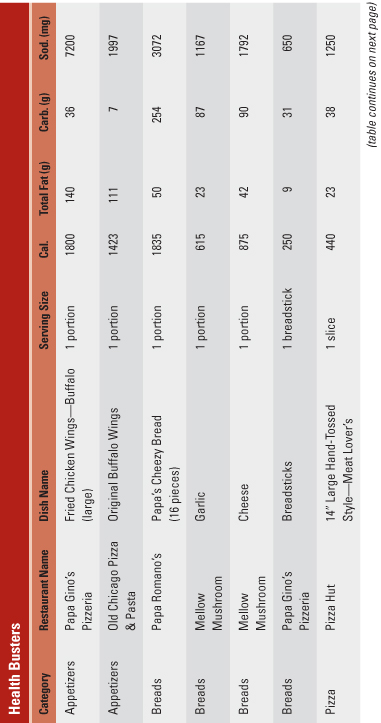
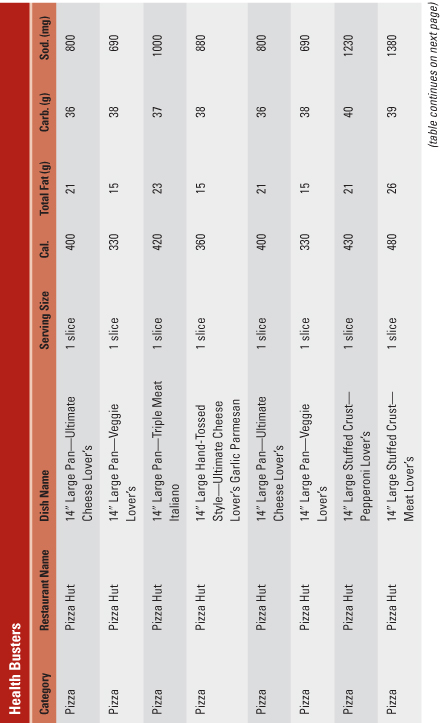


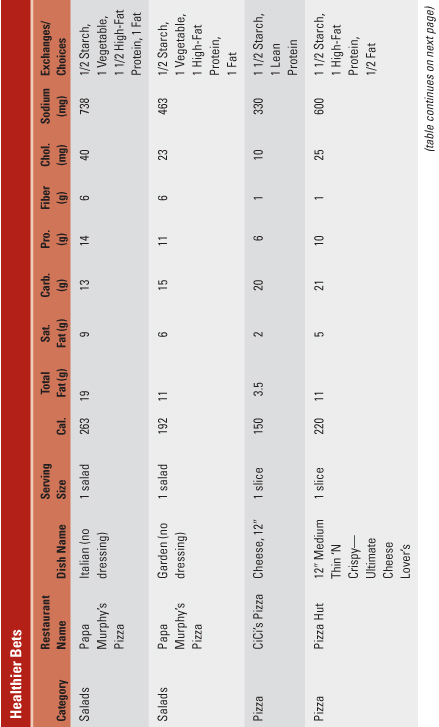

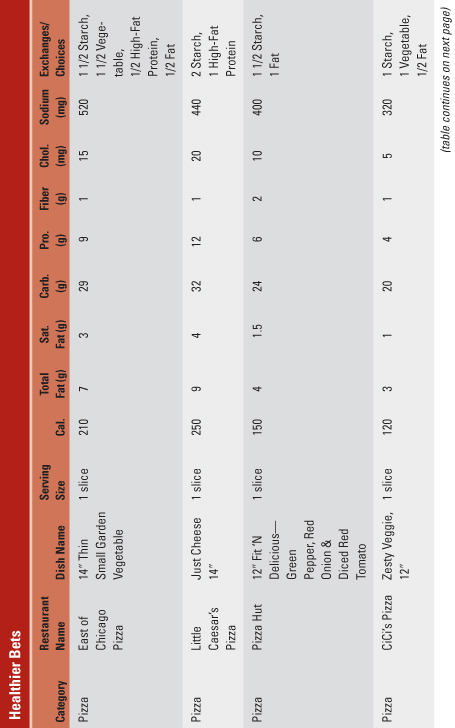



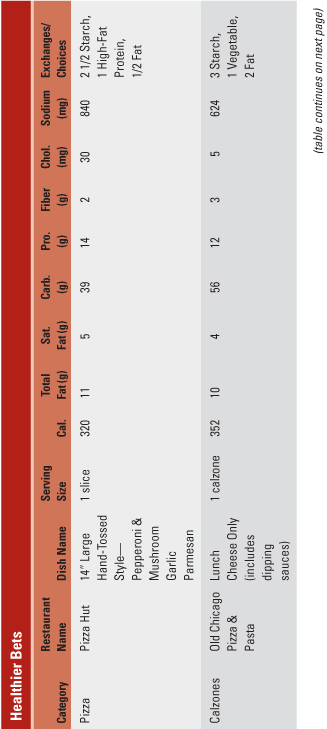

![]() Green-Flag Words
Green-Flag Words
• Anchovies (high in omega-3s, but also high in sodium)
• Artichoke hearts
• Black olives
• Broccoli
• Chicken
• Eggplant
• Feta cheese, part-skim cheese (high in sodium)
• Fresh herbs
• Garlic
• Green and red peppers
• Ham, Canadian bacon
• Jalapeño or other chilies
• Mushrooms
• Onions
• Pineapple
• Roasted peppers
• Shrimp or crabmeat
• Sliced tomatoes
• Spinach
![]() Red-Flag Words
Red-Flag Words
• Alfredo sauce
• Bacon
• Extra cheese, four cheese, six cheese
• Feta cheese
• Meatballs, hamburger meat
• Mozzarella cheese
• Pepperoni
• Prosciutto
• Sausage, Italian sausage
![]() Healthy Eating Tips and Tactics
Healthy Eating Tips and Tactics
• Stick with the thin crust and load up on the veggies.
• If your favorite chain does not publish nutrition information, check the nutrition information for similar items from two other pizza chains. This gives you ballpark figures to base your choice on.
• If your dining partner requests less-healthy pizza toppings, order healthier toppings on one half of the pizza and let your partner handle the other.
• If you count grams of carbohydrate, make sure the slices you eat are average in size. If they are bigger or smaller, change your carbohydrate estimate based on the carbohydrate information/nutrition information available. Let your eyes guide you.
• Start with a healthy garden salad to help squelch your appetite before the pizza even arrives.
• If you know a few extra pieces of pizza will be left over, package them up before you take your first bite.
![]() Get It Your Way
Get It Your Way
• Ask for your pizza to be made with less cheese, or better yet, no cheese at all.
• Substitute spicy chicken for the pepperoni or sausage on a pizza.
• Instead of extra cheese, request extra vegetables.
• Order just enough pizza for everyone at the table, to avoid that just-one-more-piece syndrome.
![]() Tips and Tactics for Gluten-Free Eating
Tips and Tactics for Gluten-Free Eating
• Unless the pizza restaurant has a completely separate preparation area for gluten-free pizzas, there is a very high risk for cross-contamination with gluten. Always question the staff carefully about their preparation areas and methods.
• Make sure any toppings are in the dedicated gluten-free area of the restaurant and any utensils used to handle gluten-free ingredients are dedicated as well.
![]() Tips and Tactics to Help Kids Eat Healthy
Tips and Tactics to Help Kids Eat Healthy
• When kids are hungry, they can easily devour more calories from pizza than their growing bodies need, especially if slices are placed in front of them with the expectation that they finish them. Try to limit the number of slices put in front of your child, and make sure they don’t feel pressure to eat beyond the point of fullness.
• Order a healthy appetizer—a garden salad or cup of soup—to help satiate your child’s appetite before the pizza arrives. Or order a garden salad to accompany the pizza.
• Introduce a new vegetable as a topping. Since kids are so familiar with pizza, and typically love it so much, it is a great vehicle to help kids feel comfortable with the idea of a new vegetable.
• There is no need for kids to get their own personal pizza. Order a pizza that can feed your whole family so that your child gets used to following the same healthy eating strategies that you follow.
![]() What’s Your Solution?
What’s Your Solution?
You are watching a sporting event with a group of friends. Your friend, who is hosting the get-together, plans to order pizza for everyone to eat while you watch the game. You don’t want to be a high-maintenance guest, but you know your friend won’t order healthy pizzas if left to his own devices.
How can you maintain your healthy eating plan even in this peer-pressured situation?
a) Text your friend before the game starts to let him know you will bring a vegetable tray for everyone to share.
b) Offer to phone-in the order. On the sly, request that all the pizzas be made with less cheese. Your buddies probably won’t even notice.
c) Speak up at the start of the get-together to place your order: a thin crust pizza with grilled chicken, red onions, and tomatoes, easy on the cheese.
d) Keep your mouth shut and enjoy two large slices of pepperoni pizza, but stop at that and enjoy the vegetables you brought along.
See the end of the chapter for answers.
![]() Menu Samplers
Menu Samplers






![]() What’s Your Solution? Answers
What’s Your Solution? Answers
a) Nice job being proactive! A vegetable tray will give everyone something healthy to chew on before the pizza arrives, making it easier to limit your pizza to just one or two slices.
b) Good job taking charge and looking after everyone’s health! Requesting less cheese is a great way to slash calories and fat. But you’re better off being upfront about it.
c) This is a smart order. The thin crust helps you keep your carbohydrate count in check, while the lean protein and vegetable toppings keep the pizza low in fat. Going easy on the cheese is always a key strategy. Just be sure you don’t overdo it on the number of slices you eat, especially if you’ll be the only one eating this pizza.
d) You know your friends best. If you don’t feel comfortable speaking up or don’t want to, then your best strategy is to limit your portion size. You may want to bring a stick of sugar-free chewing gum with you to chew on after those two slices. This will help prevent you from reaching for a third slice.